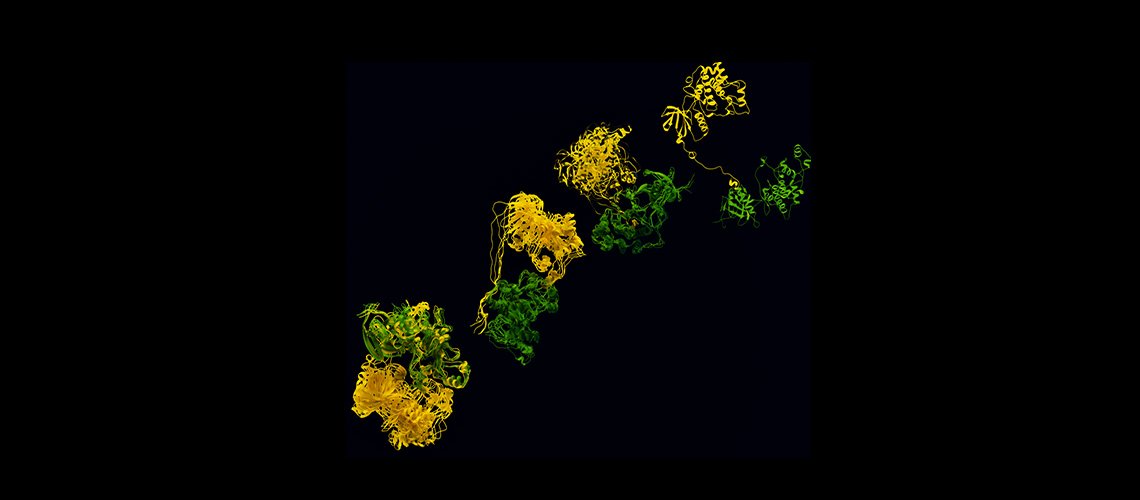Understanding the ''dance'' of signalling proteins to stop inflammation
A team from EMBL Grenoble and UNIGE shed light on the molecular activation of the MAP kinase p38α by MKK6 protein, the final ''switch'' triggering the inflammatory response.

Simulation of the nuptial dance of the two kinases identified by the research team. © Ella Marushchenko/EMBL
Inflammation is a normal response of our cells to fight stress, but too much of it can lead to a ''cytokine storm'' that can endanger life. A chain reaction of kinases activates the inflammatory response, like sequential switches. These enzymes have been heavily studied but little is known about their interactions, making it difficult to develop efficient drugs to target them. A team from EMBL Grenoble and University of Geneva (UNIGE) has obtained information about how the MAP kinase p38α, the final switch regulating inflammation, is activated by its upstream kinase. The data reveals that the two kinases engage in a finely choreographed ''dance'' leading to the formation of a specific face-to-face complex where MKK6 activates p38α. These results, published in Science, open up new directions to stop cytokine storms by targeting p38α and to study similar processes in two other families of MAP kinases, involved in cancer and Alzheimer’s disease respectively.
Cells are regularly confronted with stress – from damaging factors such as pathogens – that can alter the normal functioning of an organism. To fight stress, cells have developed several coping mechanisms, including the inflammatory response. While inflammation is necessary, too much of it can impair cell and organ function. This is the case with cytokine storms – inflammatory cascades during an infection that run out of control and can lead to severe disease and even death, as recently highlighted during the COVID-19 pandemic.
In recent work, EMBL Grenoble researchers and Gervasio Lab from the UNIGE, which uses molecular dynamic simulations, provide essential insights on a protein called p38α, belonging to the MAP kinase family, which is an important cellular ''switch'' triggering the inflammatory response. The team has not only obtained the first structure of p38α being activated by another regulatory protein kinase – MKK6 – but also unprecedented information on the dynamics (the ''dance'') of the two kinases opening up new directions to develop drugs to stop cytokine storms.
The final switch: a drug target
Inflammation is switched on via a series of kinases which activate each other in a chain reaction, the final kinase in the series being responsible for activating gene transcription required for inflammation. This process releases cytokines, pro-inflammatory signaling molecules, which, in case of overactivation, can lead to cytokine storms. This kinase chain reaction is well regulated and is similar to a logic circuit: the inflammation response requires specific buttons to be switched on, ultimately activating p38α – the meeting point where all the signals converge and the last switch of the inflammatory process.
Because the kinase chain reaction can come from different ‘branches’ of the logic circuit, this last switch is a particularly relevant drug target. The inflammatory response is regulated by p38α and is highly activated during a cytokine storm. Inactivating it could prevent inflammation from occurring, instead of trying to treat it while it is already underway. Protein kinases, including p38α, have therefore been heavily studied. However, important parts of the puzzles are still missing.
Drugs have mostly targeted the kinases’ nucleotide-binding site – a common and well-known domain present in all kinases, where the phosphate transfer occurs. This lack of drug specificity means that a drug designed to stop one kinase from signalling could also stop others. “There are countless molecules that have been designed to target p38α, especially its nucleotide-binding site, but none have yet made it past clinical trials due to this lack of specificity,” explains Matthew Bowler, a researcher at EMBL Grenoble, who co-directed this study with former PhD student Erika Pellegrini.
Cracking the activation mechanism
Using cryo-EM and complementary techniques, such as small-angle X-ray scattering (SAXS), the team managed to obtain the 3D structure of the complex and identify an unknown docking site where the two enzymes interact – valuable information to see how p38α is activated. “This could be an interesting target for inhibitors to block this specific interaction, and therefore the signal triggering the inflammatory response,” explained Pauline Juyoux, a former researcher at EMBL Grenoble, first author of the study.
For its part, the Gervasio Lab from the UNIGE, unveiled how the two kinases come together after a dynamical ''dance'' that start with a ''hug'' of the KIM domain and finishes with the formation of a face-to-face dimer. “The beauty of combining the state-of-the-art simulations with SAXS and Cryo-EM data through advanced statistical approaches is that we can ''see'' the ''courtship'' dance of the two kinases approaching one another, while knowing that what we see in the computer is fully supported by all the experimental data available,'' explained Francesco Gervasio. “The simulations required several months of supercomputing time generously allocated by the Swiss National Supercomputing Centre”, he continued, “But it was well worth it, given the relevance of the final results.”
These results provide an alternative drug target site to explore and also open the door to studying similar processes in two other families of MAP kinases: ERK kinases – which are involved in cancer – and JNK kinases – also involved in inflammation, especially in Alzheimer’s disease.
